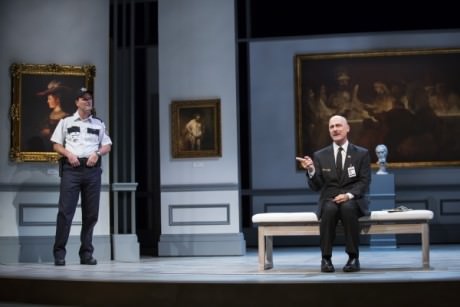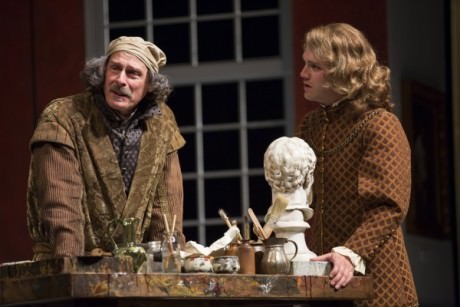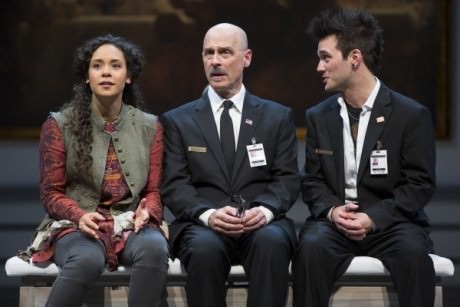Rembrandt once said, “Of course you will say that I ought to be practical and paint the way they want me to paint. Well, I will tell you a secret. I have tried and I have tried very hard, but I can’t do it, I just can’t do it! And that is why I am just a little crazy.”

Such is the perennial complaint of any artist whose talents are both celebrated and decried. Rembrandt, a genius who went bankrupt, had much early success as well as his full share of detractors. Today, he is acknowledged as one of the world’s greatest painters. The Guard explores his life and legacy, and the deeper meaning of his famous painting, Aristotle with a Bust of Homer (1653).
The Guard is a first-rate production, commissioned by Ford’s Theatre as part of the Women’s Voices Theater Festival. Playwright Jessica Dickey addresses significant issues of life, art, death, and love with wit and grace. Congratulations to Ms. Dickey, Director Sharon Ott, the actors, and the whole creative team.
As the show opens, we are in a lovely, immaculate museum. Paintings by Rembrandt are to the right, to the left, and across the back wall.
On the left, Saskia in a Red Hat (1634-42). Saskia was Rembrandt’s wife. Early portraits of Saskia suggest affection and joy in their relationship. She was a niece of Hendrick van Uylenburgh, Rembrandt’s associate and dealer. Saskia was of somewhat higher social status than Rembrandt, whose father was a miller. They married in 1634, and their first three babies survived only weeks or months. In 1641, by the time their only surviving child, Titus, was born, Rembrandt was one of the foremost painters of Amsterdam, and beginning to be known abroad. In 1942, the Year of the Night Watch, which crystallized his reputation as a painter, Saskia died of tuberculosis, leaving Rembrandt and Titus alone. Saskia is dressed in fur, feathers, silk, and velvet. Rembrandt’s love of exotic costumes is well-known. Saskia, often seen smiling, is here in profile, creating an emotional distance.
On the same side, Woman Bathing (1654), currently at the National Gallery in London, is said to be a portrait of Rembrandt’s last mistress, Hendrickje. It is painted with sharp, direct strokes. The overall impression is of one of sensuality and precise detail. Author of the biography Rembrandt’s Eyes (Knopf, 1999), Simon Schama, referred to it as “a dashing, thickly applied, suggestively broken line, a flickering light, and a provocatively unfinished finish.”
On the right we see a portrait of another important person in Rembrandt’s life—his son Titus. Portrait of Titus Reading (1658) displays all of Rembrandt’s fatherly tenderness. Rembrandt was a devoted father, and Titus appears in many of his paintings.
On the back wall is The Conspiracy of Julius Civilis, executed in 1661 for Amsterdam’s new town hall. It was his last secular history painting. It was returned to Rembrandt by the city fathers shortly after its installation, probably because they were unhappy with it. It depicts an episode from Tacitus regarding the rebellion of the Batavians, who were ancient inhabitants of the Netherlands. (69—70 AD). This revolt, against the Roman Empire, was led by the one-eyed native, Claudius Civilis. The painting is now considered one of the best historical Baroque works of the 17th century.
The 1659 Self-Portrait, which can be found here at the National Gallery of Art, reminded me of times I have stared, fascinated, at another Rembrandt Self-Portrait in the Frick Collection in New York. Here, the self-portrait shows a hollow-cheeked, serious Rembrandt, wearing a black beret. The losses and reverses of his later years lie heavily upon him. All of suffering humanity seems reflected in his tormented eyes.
At first, we see a spotlight on Henry (Mitchell Hebert) who has come in early. He has been at the museum, as one character notes “longer than most of the art.” In his imagination, the paintings come alive at night, and he likes to come in early to catch the transition. He is joined by security guard Jonny (Tim Getman), one of those well-meaning, unintentionally amusing, inept people who attempt to comfort us in times of crisis. Getman’s Jonny is adroitly comic, as he receives orientation from Henry on his first day as a museum guard. Henry’s partner Simon, a well-known poet, is dying of Stage IV cancer. Mitchell Hebert’s Henry gains in depth and sensitivity as the play progresses. It is a moving portrait of a mature man coping with loss.
Henry and Jonny are joined by two young people, Madeline (Katherine Tkel) and Dodger (Josh Sticklin). Madeline has just turned to painting to help her through the death of her grandmother. Dodger is a graffiti artist with a bipolar mother who explains that he is “not mentally ill, just artistic.” There is an immediate attraction between the two: he thinks “rules suck”, while she believes in following them. He encourages her to touch the painting she is copying, Aristotle with a Bust of Homer. She refuses. Henry gently suggests that perhaps Madeline is one of those people who come to a museum because they are “souls on the verge of an understanding.” Katherine Tkel as Madeline and Josh Sticklin as Dodger inhabit their roles with understanding and warmth.

Aristotle with a Bust of Homer (1653) is one of Rembrandt’s most famous paintings. Aristotle, who wrote the Poetics explaining the differences between drama and epic poetry, remarks “Homer has taught all other poets the art of telling lies skillfully.” The painting, currently at the Metropolitan Museum of Art in New York, was painted for Sicilian nobleman Antonio Ruffo, who paid 8 times more for it than the average sum charged by Italian artists.
Both Homer and Aristotle, like Rembrandt, had misfortunes despite their fame. Although we know little about Homer’s life, his blindness is a constant theme among those who write about him. Aristotle lived 500 or more years after Homer. In the picture, he has his hand on Homer’s head and is looking contemplatively off in the distance. He wears a golden chain, with a medallion suspended from it. The traditional interpretation is that the medallion contains a portrait of Alexander the Great, who was Aristotle’s most famous pupil. To emphasize Homer’s blindness, Rembrandt keeps the light off his face.
The play is in four parts. The first is at a major art museum, where Henry, Dodger and Madeline finally give in to touch the painting; next is Rembrandt’s sumptuous home in 1653 Amsterdam, where the artist is complaining about having to paint a philosopher. As the scene changes, we turn to a Doric temple and the year 800 BC in Greece, where Homer muses about his life and work. The final scene takes place in the bedroom of the dying poet, Henry’s partner, Simon.
The first scene at the museum is delightfully comedic and touching. Ms. Dickey’s talent shines as we grow to understand and care about her characters. In the second scene, Mitchell Hebert is an extremely convincing Rembrandt, and Josh Sticklin is a thoughtful and worried Titus. This scene is especially poignant when one remembers that in Rembrandt’s last years he became financially dependent on his son. As Henny, Rembrandt’s mistress (he only had one wife) Katherine Tkel is patient, wise, and exceptionally understanding, all of which is probably necessary given her role in his life.
Much is made here of Rembrandt’s suffering, but it must be said that he was no saint. He sold Saskia’s grave, because the plague had caused so many deaths in Amsterdam that space was at a premium. To be fair this was not considered unusual during the 17th century plague years. However, his first mistress (and his son’s nurse), Geertje, became distraught when she realized she was to be replaced by Hendrickje. She sued him, claiming he had promised to marry her. He had her committed to a house of correction.
Rembrandt’s excessive spending is emphasized, but Dickey has skillfully given us a Rembrandt whom we can appreciate in his best light; a man who, though temperamental, cares deeply about his mistress and his son.
Craig Wallace’s Homer is a tour-de-force of acting. His Homer is not blind (I suppose that came later) and he is modest enough to admit that some parts of his work are not, well, exactly gripping. This Homer seems far from the man who is said to be responsible for the savage magnificence of the Iliad. However his sense of humor is marvelous, and although I personally doubt that Homer spent much time worrying about a straying wife, Wallace makes it all deliciously believable.

The last scene is beautifully acted. All the joy and awkwardness of a long relationship is on display, as Henry and his partner Simon (Craig Wallace) attempt to cope with the inevitable. The compassionate but matter-of-fact attendant, Martin (well played by Tim Getman) leaves the two men alone. The Angel of Death hovers over the proceedings, but love proves to be the stronger. The fragility of life in the face of mortality is contrasted with the lasting impact of art. Yet Dickey reminds us, rightly, that the multi-million-dollar paintings we see on those handsome walls were made by flawed human beings who struggled and sacrificed.
In each setting, the museum, Rembrandt’s studio, an ancient Greek temple, and Simon’s bedroom, the design enhances and expresses the soul of the play. Scenic Designer James Kronzer contributes immeasurably to the tone of the piece.
Laree Lentz’s costumes are equally lovely. Several appear to be inspired by Rembrandt’s paintings. Rui Rita’s lighting resonates appealingly in each scene. Particularly striking is the spotlight on Henry in the beginning. Rob Milburn and Michael Bodeen, Sound Designers and Composers, do superb work, creating a harmonious “frame” for this engaging picture.
French writer and critic Edmond de Goncourt said, “A painting in a museum hears more ridiculous opinions than anything else in the world.” In Dickey’s play, we are asked to consider the lives of those who guard the paintings, and, in a sense, to step inside a painting itself.
Running Time: 90 minutes, with no intermission.
The Guard plays through October 18, 2015, at Ford’s Theatre – 511 10th Street, NW in Washington, DC. For tickets, call the box office at (800) 982-2787, or purchase them online.
LINK:
The Women’s Voices Theater Festival: ‘The Guard’ at Ford’s Theatre reviewed by Jeanette Quick.





